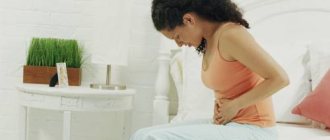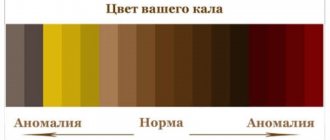There are norms for physiological secretions of the human body. In particular, feces are assessed by consistency, color, smell, and composition. In healthy people, stool has a shaped appearance, a soft consistency, and a brown color ranging from light to dark brown.
If green stool is noticed, it often becomes a frightening factor and forces people to look for pathology. We will look at the causes of green intestinal discharge. To do this, let us first briefly recall what determines and how the color of stool is formed.
Why is stool brown?
The color of stool is formed mainly due to bile pigments, which are formed in the liver cells and then enter the intestines with bile. They are a product of the processing of the iron-containing part of erythrocyte hemoglobin (heme) and myoglobin in muscle tissue. In addition, the spleen takes part in the breakdown of red blood cells. Old blood cells are disposed of, unnecessary substances are sent to waste.
Similar pigments are found in mammals, lower vertebrates and invertebrates, in bright green plants and red algae. The biochemical reaction goes through the stage of formation of greenish-blue biliverdin, yellow-orange bilirubin. Bacteria act on bilirubin in the intestines. Their enzymes convert biliverdin into stercobilinogen (up to 280 mg per day).
Under the influence of light, stercobilinogen excreted in feces is oxidized into stercobilin with a brown color reaction. In addition to natural pigments, coloring substances of undigested dietary fibers, waste products of bacteria, and processed residues of medicinal substances are excreted in feces. Therefore, the color is unnatural.
Why does stool turn light yellow?
Light yellow stool is often observed in children and is considered normal.
The first thing to understand is that light yellow stool is not necessarily a signal of the presence of disease in the body. It can become this way due to frequent consumption of dairy products, as well as some other foods. Therefore, if stool of this color appears, you should consult a doctor and conduct additional tests. Basically, stool turns light yellow for the following reasons:
- Pancreatic dysfunction. The most common cause of light yellow stools. It is due to the fact that as a result of deterioration in the functioning of the organ, it secretes a smaller amount of digestive enzymes involved in the absorption of fats. It is the presence of undigested fats that leads to coloring of stool. Also, these enzymes are directly involved in the overall process of digestion of essential nutrients, so light yellow feces may indicate a general deterioration in digestion.
- Diseases of the liver and gall bladder. Some diseases of these two organs can also lead to a change in the color of stool. In this case, due to disruption of the liver and gallbladder, namely when the process of bile secretion is disrupted, and bilirubin enters the digestive system unchanged, the stool turns bright yellow. In this case, the urine may become more saturated in color and more concentrated. Therefore, it is recommended not to delay your visit to the doctor, since disturbances in bile secretion are a serious problem.
- Increased fermentation in the intestines. One of the reasons why a change in the color of a person's stool may occur. Stool also turns yellow when a person consumes large amounts of dairy products. This phenomenon is very often observed in infants who are breastfed or consume milk cereals. During this period, they may have light yellow stools, which does not indicate any illness.
Stool can turn yellow for various reasons. Sometimes this happens when consuming dairy products, and sometimes it indicates diseases of the pancreas, as well as diseases of the liver and gall bladder.
What is normally associated with green stool in an adult?
It is important to consider that deviations in stool color or consistency always have their own explanation. It is not necessarily associated with a pathological process. The causes in an adult can be divided into physiological (nutritional) and pathological.
The nature of digestive disorders is judged by the shade of stool.
Physiological ones include:
- Eating foods containing chlorophyll. It is a green pigment found in plants. The highest concentrations are found in leafy vegetables, green peas, lettuce, spinach, broccoli, and parsley.
- Chemical dyes are specially added to some products (sweets, cocktails, marmalade, fruit and berry jelly). An example is blue Curacao, an intense blue color (included in cocktails). But if a person has consumed a salad of carrots and beets along the way, then the “output” is a mixed color of light green or yellow-green.
- Stools may turn dark green after eating food dyes due to functional constipation caused by stress. The stool takes on a hard consistency.
- On the contrary, with diarrhea caused by anxiety, passing through the intestines at an accelerated pace, biliverdin does not have time to transform into stercobilin. Therefore, it is possible that the stool is green and liquid in appearance.
- Food products also include red meat, seaweed, seaweed, fish, and red beans. They have a high iron content. This means that during processing, excess biliverdin is formed.
One of the common causes is a consequence of taking antibiotics, ferric ferricyanide (prescribed for the treatment of heavy metal poisoning). For non-pathological reasons, the person has good general health, no abdominal pain, normal temperature.
Causes of dark green stool
Vegetarians very often experience stool disorders.
Why does the stool turn dark green? In this case, changes in the shade of feces are caused by the plant pigment chlorophyll. It is found in spinach, arugula, parsley, dill, Brussels sprouts, green beans and other leafy vegetables. A large amount of fiber provokes similar symptoms as a result of accelerated transport through the intestinal tract. Another reason for the appearance of dark green stool is metabolic disorders. The fact is that the bile pigment biliverdin, during rapid evacuation, does not have time to complete the complete decay process. As a result, the substances preceding it can be found in feces instead of brown stercobelin. Therefore, with diarrhea, as well as when using laxatives, stool becomes green in color.
Antibacterial medications can even cause dark green diarrhea. The state of dysbacteriosis with the development of fermentation and rotting processes of eaten food products causes similar symptoms.
Conditions accompanied by fever for more than a day, pain in different parts of the abdomen, nausea and vomiting require special attention. These may be signs of serious intestinal infections such as dysentery.
With pancreatitis, all characteristics of stool may change. Liquid stool becomes yellow-green in color (sometimes light yellow), with a shiny surface. These stools have a strong stench and are very difficult to wash off.
When examining the coprogram, dietary fiber and fatty inclusions are detected. With pancreatitis, a large amount of fat in the stool appears due to a deficiency of the enzyme lipase, which breaks down fats. An additional contribution is made by an incorrect diet with a large amount of fatty, fried, smoked foods.
The most important diagnostic criteria for pancreatitis are biochemical indicators (lipase, amylase, trypsin), as well as instrumental studies such as ultrasound, computed tomography, radioisotope scanning, echography.
When should you suspect pathology?
Green stool is a symptom of pathology:
- for liver diseases;
- increased breakdown of red blood cells;
- celiac disease;
- enterocolitis;
- intestinal tumors;
- gastrointestinal bleeding.
Disruption of the digestive process causes a failure in the production of enzymes and juices of the organs concerned. This is reflected in the transformations of bilirubin derivatives in the intestines. Celiac disease is an inherited autoimmune disease caused by the protein gluten, which destroys the villi in the small intestine. As a result, atrophy of the small intestine occurs and the absorption of fats and carbohydrates stops.
The disease begins both in childhood and after 40 years
Intolerance to lactose, the enzyme that digests milk. Appears during the neonatal period. When breastfeeding begins, the baby's stool is liquid and green in color. An adult knows about his peculiarities. Does not consume dairy products. But sometimes it cannot provide for the inclusion of dairy additives. Therefore, he is not upset when he sees the changed color of stool.
In case of an inflammatory process in the intestines (enterocolitis, Crohn's disease, ulcerative colitis), the green tint of stool is provided by leukocytes, pus, and rapid movement during diarrhea. Purulent discharge from an ulcer in the lower parts of the large intestine does not mix with feces, but looks like a layer or film. The patient has cramping or nagging pain in the abdomen, a fever, and weakness.
Salmonellosis is a common intestinal infection. Often occurs in the form of group outbreaks in children's institutions and food facilities. The infection comes from contaminated meat, dairy products, eggs with insufficient cooking. The source could be a sick employee. Detection of a disease is a reason for an extraordinary inspection by epidemiological surveillance authorities.
The disease has an acute onset. There is a sharp increase in temperature, nausea, vomiting, frequent diarrhea with greenish stools. In children, fluid loss can lead to dehydration syndrome. Profuse bleeding of the vessels of the stomach or intestines in the complicated course of peptic ulcers, colitis, Crohn's disease is accompanied by liquid black tarry stools.
The color is caused by the reaction of hemoglobin in red blood cells with hydrochloric acid in gastric juice, forming hemosiderin. The color of the stool may change to black-green.
The patient’s condition is not necessarily accompanied by previous abdominal pain. Symptoms are characterized by:
- vomit the color of coffee grounds;
- increasing weakness;
- pale skin;
- weak rapid pulse and decreased blood pressure.
Diseases of the liver, biliary system, and pancreas cause obstructive jaundice by blocking the outflow of bile. Due to insufficient output of bilirubin, stercobilin is not formed in the intestinal contents. The stool turns grey-green. At the same time, the urine darkens intensely, and yellowness appears on the sclera of the eyes and skin, as the pigment enters the blood. This sign is an important symptom of viral hepatitis.
Salmonellosis is one of the pathologies that provokes the appearance of green feces
At the same time, the patient notes weakness, loss of appetite to the point of aversion to food, nausea, and bloating. Dysbacteriosis in the intestines occurs after taking antibacterial agents. The lack of beneficial flora activates rotting and fermentation. Patients experience flatulence, greenish feces, and moderate abdominal pain. In people prone to allergies, a reaction to certain foods may include diarrhea with a green tint.
Pathological sources
The reasons for dark-colored stool in adults and children are the development of diseases of the gastrointestinal tract.
| Disease | Mechanism of symptom development |
| Gastritis of erosive form in acute or chronic course | The unnatural color of stool is caused by an inflammatory process in the stomach, the appearance of microcracks, and internal bleeding. |
| Ulcerative lesions of the stomach and duodenum | Injuring the neoplasm with solid remnants of undigested food promotes the release of blood from it, which, mixing with feces, changes its color to a darker shade. |
| Hypertrophy of the gastric mucosa | The pathology is characterized by the proliferation of organ tissue and the formation of a benign growth, which can be injured by solid food and change the color of stool. |
| Liver cirrhosis in atrophic form | A change in the color of stool occurs against the background of a degenerative process in the tissues of the gland. |
| Splenic vein thrombosis | The pathology occurs with an increase in the size of the organ, impaired circulation, resulting in black loose stools and vomiting with blood. |
| Oncological process in the stomach, duodenum, esophagus | A tumor forms due to the lack of treatment for benign growths (ulcers, polyps, etc.). Blood in the stool is caused by trauma to the growth from solid food. |
How to find out the reason
If greenish feces appeared once after eating the listed foods or drinks, then there is no reason to worry. You need to pay attention to the color after 1-2 days. Persistent changes due to the use of medications require clarification from the attending physician. Perhaps it is better to stop the individual reaction by abandoning the drug and switching to another analogue.
Severe, persistent symptoms of impaired consistency of stool in combination with a green color require diagnostic measures. First of all, you should visit a doctor and tell about all the signs. If you suspect food poisoning or infection, you need to be prepared to report the food you took the day before and where you were eating.
If you have elevated body temperature, vomiting, or diarrhea, you should call a doctor at home. If liquid black-green stool is released against the background of vomiting with dark contents, gastrointestinal bleeding cannot be ruled out. This is especially likely in patients with peptic ulcers or gastritis. You need to call an ambulance; it is impossible to make an accurate diagnosis on your own.
How to test feces for occult blood?
Depending on the severity of the condition, patients are taken to a hospital, where they are examined while providing the necessary medical care. The set of diagnostic measures includes:
- a blood test with a leukocyte formula; if bleeding is suspected, a test for hematocrit, blood group and Rh factor, and electrolytes is prescribed;
- general urine test and for diastasis;
- biochemical tests for liver pathology;
- feces for scatology;
- tank sowing feces and vomit.
Only a doctor can understand the pathology of elderly people
On the first day, the patient undergoes hardware examinations;
- Ultrasound of the abdominal organs;
- electrocardiogram;
- fluoroscopy of the stomach with barium suspension;
- fibrogastroscopy.
If necessary:
- Colonoscopy is performed under anesthesia;
- computed and magnetic resonance imaging.
The list of studies depends on the symptoms of the disease and the severity of the patient’s condition.
Why does the color of stool change?
Not everyone pays attention to changes in the color of stool, but the sooner the cause of this condition is identified and appropriate treatment is started, the more favorable the prognosis and the lower the risk of complications.
It is especially important to visit a doctor if there is pain in the lower abdomen or perineum during bowel movements, constipation, indigestion, or other symptoms characteristic of digestive disorders.
Causes of darkening of stool
A change in the shade of stool to a darker color may be due to serious diseases. However, this is not always the case, and often the symptom requires only lifestyle adjustments without taking medications.
Therefore, doctors divide all the reasons for changes in stool color into 2 large groups:
- physiological, caused by the inclusion of certain foods in the diet or taking medications;
- pathological, caused by the development of serious diseases in the organs of the digestive system.
It is not difficult to relieve the physiological cause of the symptom: it is enough to exclude a specific product from the diet or complete therapy with a medication that affects the change in the color of stool. If the pathological etiology of the symptom is confirmed, then you cannot do without the help of a doctor.
You can indirectly determine what reason, physiological or pathological, caused the change in the color of the stool by looking at your general health. In the first case, it is not disturbed, unlike the development of diseases of the gastrointestinal tract.
Causes during pregnancy
Digestion in a pregnant woman is no different from the physiological processes of a healthy person. It is possible that sensitivity to certain foods increases due to a change in taste. Therefore, the basis for green stool during pregnancy should be sought in nutrition. Pregnant women enjoy eating: broccoli, dill, spinach, parsley. An increase in the rate of transit of such plant products through the intestines has an effect.
Some vitamin supplements containing iron also affect stool color. They are prescribed by obstetricians quite often to prevent anemia. Managing pregnancy in women with chronic diseases requires the attention of a doctor and relatives. It is impossible to predict an exacerbation in advance. Therefore, it is necessary to come early for examination if you have suspicious bowel movements.
The ban on spicy foods and pickles increases the need for fresh greens
Gray color of stool
With the start of taking medications such as bismuth preparations containing iron, activated carbon, aspirin, ibuprofen or products with dark pigment, the appearance of gray stool is natural.
This condition does not require discontinuation of medications or additional treatment; there is nothing to worry about. But feces with a putrid odor and a dark gray hue indicate significant disturbances in the digestive processes. This may be nonspecific ulcerative colitis or putrefactive dyspepsia. With pancreatitis, inflammatory foci of glandular tissue become swollen. As a result, the lumen of the bile ducts passing through the pancreas is significantly reduced. Gray stools are formed due to insufficient flow of bile into the intestines.
Treatment measures at home
Treatment of diseases is carried out in the infectious diseases department or gastroenterology, depending on the diagnostic results. If salmonellosis is suspected, pre-medical care includes:
- plenty of drinking regimen, even when vomiting you should give boiled warm water to drink in small portions, the best drug is Regidron;
- taking sorbents - drugs that attract toxins in the intestines and remove them with feces; activated carbon (every 2 hours an adult should drink 4 tablets), Smecta, Polysorb are suitable.
Do not rinse the stomach, give antibiotics or drugs that stop intestinal motility. Toxic substances should be removed with diarrhea. If bleeding is suspected, the patient should be placed on his side, prohibited from getting up, a heating pad with ice or cold water should be placed on his stomach (something from the freezer, wrapped in cellophane and a towel will do), you can allow him to swallow small pieces of ice.
How to treat the symptom?
Before determining a method of treating dark stool in an adult or child, a comprehensive diagnosis is prescribed, based on the results of which the cause of the condition is identified.
If the symptom is caused by internal bleeding in the gastrointestinal tract, urgent measures are taken. In this case, in addition to dark bloody stools, other symptoms are present:
- weakness;
- paleness of the skin;
- dizziness;
- nausea and vomiting with blood;
- increased heart rate.
If there is severe internal bleeding, heart failure rapidly increases. If appropriate treatment is not carried out immediately, the risk of early death increases. If characteristic symptoms occur at home, you should immediately call an ambulance.
Before the doctor arrives, it is prohibited to take any medications, including hemostatic agents. This smoothes out the clinical picture and complicates medical diagnosis.
Treatment of the physiological symptom does not cause difficulties. It is enough to exclude the provoking factor: remove a specific product from the diet, stop drug therapy, etc. For pathological etiology of changes in stool color, specific therapy is prescribed.
For erosive gastritis and ulcerative lesions of the gastrointestinal tract
Mild erosive gastritis is treated with drugs that reduce the acidity of gastric juice and prevent the progression of damage to the mucous membrane.
In severe cases, for example, with bleeding, endoscopic hemostasis and the administration of proton pump inhibitors or H2 blockers are practiced.
Surgical intervention is prescribed extremely rarely. How to treat ulcerative lesions of the stomach and duodenum depends on the causative factor.
Features of disease therapy:
- Taking antibacterial drugs to eliminate Pylori bacteria that caused the pathological process (confirmed by laboratory diagnostic results).
- Taking medications that reduce stomach acid production (proton pump inhibitors or antacids). Medicines are used as symptomatic therapy to alleviate the condition. Prescribed for a period of no longer than 2 weeks.
- Avoid taking non-steroidal anti-inflammatory drugs, which enhance the clinical picture of ulcerative damage to the organ. To eliminate pain, the doctor selects an analogue from another medicinal group.
During the period of treatment for erosive gastritis and gastric or duodenal ulcers, you must follow a diet excluding alcohol, spicy, fried, and fatty foods from the diet.
For hypertrophic changes and gastric cancer
Hypertrophy of the gastric mucosa is treated conservatively or surgically. In the first case, a special diet is prescribed:
- inclusion of high protein foods in the diet;
- consumption of food pre-processed by thermal and mechanical means;
- exclusion of irritating foods (fatty, fried, spicy, alcoholic drinks, etc.).
Anticholinergic, enveloping and astringent drugs are prescribed from medications. Replacement therapy with the administration of natural gastric juice, hydrochloric acid, Panzinorm, Polyzyme and other drugs may be required.
If conservative therapy is ineffective, surgical intervention (partial or complete gastrectomy) is performed. Indications for surgery: severe pain that cannot be controlled with medications, repeated bleeding, swelling.
In case of an oncological process in the stomach or duodenum, the tumor is removed with partial resection of the organ or complete excision. Before and after surgery, radiation and chemotherapy are prescribed.
For atrophic cirrhosis of the liver and thrombosis of the spleen
If atrophic cirrhosis of the liver develops, a Pevzner diet is prescribed: split meals, reducing the volume of protein-containing foods, excluding spicy, fatty, fried, smoked meats, salt, and alcoholic beverages.
Medicines used for atrophic cirrhosis of the liver:
- pituitary hormones (to reduce blood supply and reduce pressure on the portal vein);
- agents from the group of nitric acid salts (to dilate veins and arterioles, reduce blood flow to the liver);
- beta-blockers (to reduce the strength and frequency of heart contractions, which helps reduce the process of blood filling the gland);
- diuretics (to remove excess fluid from the body).
Also prescribed are drugs from the group of water-soluble proteins, lactulose drugs, and analogues of adrenal hormones.
Surgery for atrophic cirrhosis of the liver is performed in severe cases when conservative treatment is ineffective. This could be devascularization, splenectomy, or organ transplantation.
Splenic vein thrombosis is treated with thrombolytics, anticoagulants, and antiplatelet agents. To prevent pylephlebitis, antibiotics and antifungal compounds are administered. The intensity of pain can be reduced with analgesics from the NSAID group.
In advanced cases of pathology, splenorenal or mesocaval shunting and splenectomy are performed.
When should parents worry?
If you have diarrhea accompanied by light gray, almost white stools, you should be wary. In this case, the cause of deviations may be disruption of the liver, pancreas, and bile ducts. Often similar symptoms occur with pancreatitis, and they manifest themselves clearly. Since pancreatitis in children is extremely rare, it is worth seeking qualified help so that the doctor can make an accurate diagnosis.
In an infant, light grayish feces mixed with mucus may indicate the presence of inflammatory and infectious diseases. Such ailments necessarily require the use of antibiotics, which can only be prescribed by an infectious disease doctor.
If the baby has a dirty gray coating on the poop, and all this is accompanied by a strong unpleasant odor, this indicates that the child’s diet needs to be diversified. As a rule, a pediatrician helps with this; he will give advice to parents regarding the correct nutrition of the baby.
You need to worry if the stool in a newborn is accompanied by the following symptoms:
- There is pain in the abdomen;
- mucous membranes and skin acquire a yellow tint;
- temperature rises;
- urine becomes dark;
- the baby refuses food and rapidly loses weight;
- the abdomen increases in volume and becomes bloated;
- the child becomes lethargic, apathetic, and irritable.
If at least one symptom of all of the above is present, you should contact a doctor immediately! The specialist will prescribe special tests (biochemical, bacteriological analysis of stool, as well as coprogram) in order to establish the cause of this condition in the infant.










